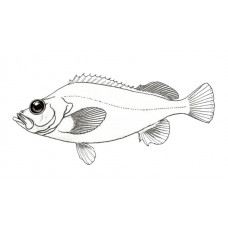Latin name
Sebastes norvegicus
Other name
Red fish, Red perch, Ocean perch, Rosefish, Norway haddock, Norwegian carp.
Identification
Golden redfish are characterized by a laterally compressed, tall body and a large head. The mouth is slanted upward. The eyes are large, their diameter not less than the length of the snout. The lower jaw has no well-defined bony protuberances. The supraorbital spines and ridges of the upper part of the head are relatively underdeveloped.
Features of fish fins
The spiny dorsal fin of this fish is low. It has more than 13 barbed rays.
Fish colouring
The body and fins of the golden redfish are orange-red, fading to yellowish-white on the belly.
Distribution
Golden redfish are common in the eastern Atlantic: Kattegat and North Sea, north to Svalbard, southern Barents Sea, east to Kanin Bank and Novaya Zemlya, rare in the White Sea, Iceland and eastern Greenland. Western Atlantic: from Greenland and southeastern Labrador in Canada to New Jersey in the USA.
Habitat
A marine pelagic-oceanic oceanodromous species that prefers temperate climates. Its depth range is 100-1000 m, usually 100-500 m. Juveniles of these fish are found in fjords, bays and coastal waters.
Size
Slow-growing species. Maximum length of males of this species is 100.0 cm; total length: 45.0 cm. Maximum reported weight: 15.0 kg. Maximum reported age: 60 years.
Behavior
A gregarious species throughout its life. Significant migrations occur only after sexual maturity. There are migrations of females to rear larvae, winter migrations of females and immature fish of both sexes, and feeding migrations accompanied by the unification of herds of females and males.
Food and feeding habits
Golden redfish feed primarily on euphausiids in the summer, herring in the fall and winter, and sardines, herring, euphausiids, and scallops in the spring.
Reproduction
These are oviparous fish; the sex glands of the male and female do not mature at the same time. After copulation, sperm remain in the female's ovary until the eggs mature, paving the way for fertilization. Mating occurs in late summer or early fall. In winter, females give birth to 50,000 to 350,000 8 mm long pelagic larvae.
Fishing
This species is of commercial importance in fisheries. It is usually trawled in deep waters.
Relationship with a person
Reports of ciguatera poisoning.
| Classification | |
| Phylum | Chordata |
| Class | Actinopterygii |
| Squad | Perciformes |
| Family | Scorpaenidae |
| Genus | Sebastes |
| Species | S. marinus |
| Features | |
| Conservation status | Least Concern |
| Habitat | Pelagic |
| Life span, years | 60 |
| Maximum body weight, kg | 15 |
| Maximum length, cm | 100 |
| Sailing speed, m/s | No information |
| Threat to people | Edible |
| Way of eating | Predator |
Golden redfish
Tags: golden redfish

